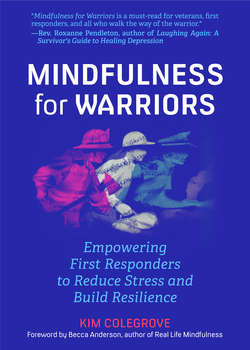Читать книгу Mindfulness For Warriors - Kim Colegrove - Страница 8
На сайте Литреса книга снята с продажи.
ОглавлениеIntroduction
“To know even one life has breathed easier because you have lived. This is to have succeeded.”
—Ralph Waldo Emerson
Here’s how this whole thing started.
Me: I want to teach cops how to meditate.
Pretty much everyone else on the planet: You will never get cops to meditate.
Me: Hold my beer.
The catalyst to this work was my husband’s death by suicide in 2014. I never intended to become an advocate for culture evolution in law enforcement and other first-responder professions, but here I am.
Meditation and mindfulness are personal practices that empower an individual to become familiar with and regulate the self. They are evidence-based, meaning there’s research to support my mission. When you learn these skills and practice them regularly, you can use them to settle and neutralize your system—mentally, physically, and emotionally.
Nobody needs this information more than emergency responders—police, firefighters, EMTs, paramedics, other EMS roles, dispatchers, corrections officers, active military and veterans—and I’m also going to include social workers and other mental health professionals, clergy, ER professionals, and others in the mix. Although these would not technically fall under the heading of “first responder,” their experiences of stress, trauma, and secondary trauma mirror those of first responders.
The technical definition of a first responder is a person designated or trained to respond to an emergency. Although we typically think of a police officer, firefighter, or paramedic, there are so many other professions that operate under the umbrella of the definition. I want to be inclusive, because I’ve learned that there are commonalities among all of these professions when it comes to the effects of stress and trauma.
My challenge, and frankly the challenge of first responders, is breaking through the stoicism and stigma that pervade most of these professions. Traditionally, these cultures encourage first responders to stay quiet about emotional or mental distress. They learn early on that they are expected to accept the inevitability of organizational stress and dysfunction, debilitating stress symptoms, emotional upheaval, sleep disruption and disorders, marriage problems and divorce, and substance use and abuse.
The coping mechanisms that are most often modeled and accepted in these cultures include excessive drinking, the use of prescription drugs, risky behavior, avoidance, and black humor (telling jokes and laughing about the shocking, disturbing, and gruesome things being experienced on the job). Makes sense, doesn’t it? If a person isn’t allowed to feel and show normal human emotions, at least the laughter provides some relief from the bottled-up pain, grief, sorrow, anger, fear, and despondency.
Meditation and mindfulness are coping mechanisms that can help a person learn to modulate stress and emotion for the purpose of self-regulation. They require stillness and silence, and yes, they require observation and feeling. But wait, there’s more.
These powerful personal practices can also empower a person to choose focus and intensity when needed, and de-escalation when desired. Can you imagine this level of self-discipline and relief?
For those of you concerned that you’ll lose your edge, please don’t worry. I’m not asking you to sit down and meditate in the middle of a crisis. Rather, I’m suggesting that you use these tools between crises and train yourself to harness the power to defuse and de-stress when you need to or want to.
Hypervigilance is a big problem in the first-responder community. Yes, your senses need to be heightened at work, and your ability to focus and react is what makes you an excellent first responder. But you might not need the same level of intensity on every call or with every interaction, especially at home. The problem is, hypervigilance gets locked in, stresses your biological systems, and can hurt the people around you. Same with anger, hostility, aggression, defensiveness, negativity, and apathy.
So, I’m asking first responders to set aside their preconceptions and skepticism and give me a chance—to give meditation and mindfulness a chance. The status quo is not working. Our first responders are stressed and traumatized, and they are dying at alarming rates, sometimes prematurely, due to stress-related health problems, sometimes in line-of-duty deaths, and way too often by their own hand.
What I present, in my classes and in this book, is an introduction to the concept of meditation and mindfulness as healing tools. I am offering a simple, straightforward, logical way for you to dip your big toe into the pool, so to speak. If, when you finish this book, meditation appeals to you on any level, but you are not connecting with my style of instruction, please don’t give up! All it takes is a quick search of the internet to find other practices and techniques. I promise, you can find something that works for you.
Also, you should know, I am teaching cops to meditate, and they are loving it! In fact, I’m working with first responders from all professions and they are embracing these once new-agey, now mainstream practices with open arms. Well, they embrace them with open arms after begrudgingly sitting in class with their arms crossed in front of them for the first thirty minutes. I love the challenge!
So here we go. Uncross your arms and set those preconceptions aside. I have some things I’d like to share with you, because I really want you to live a long, healthy, happy life. You deserve it.
